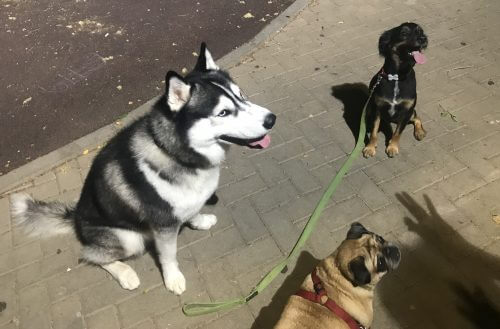A new study comparing the anatomy and behavior of dogs and wolves indicates that the anatomy of dogs has changed over thousands of years to allow them to communicate better with humans.

The dogs raise their eyebrows when we talk to them. Now the evolutionary reason for this has been found. The dogs developed new muscles around the eyes to better communicate with humans. Left: Siberian Husky, one of the oldest breeds that did not develop the eyebrow lifting muscle. Photo: Avi Blizovsky
A new study comparing the anatomy and behavior of dogs and wolves suggests that the anatomy of dogs has changed over thousands of years to allow them to communicate better with humans.
In the first detailed analysis comparing the anatomy and behavior of dogs and wolves, the researchers found that the facial muscles of the two species are similar, except for those above the eyes. Dogs have a small muscle that allows them to raise their inner eyebrow, a muscle that wolves do not have.
The authors hypothesize that the inner eyebrow movement causes a nurturing response in humans because it makes the dog's eyes appear larger, more babylike and also resembles the movement of humans when they are sad.
The research team, led by comparative psychologist Dr. Julian Kaminsky, from the University of Portsmouth, included behavioral and anatomical experts from the UK and the US. It was published in the journal PNAS.
Dr. Kaminsky explains: "The evidence that dogs developed a muscle that would allow them to raise their inner eyebrow after they were domesticated by wolves is convincing.
"We studied the behavior of both dogs and wolves, exposed to a human encounter for two minutes, dogs raised their inner eyebrows with a higher intensity than the wolves.
"The findings indicate that expressive eyebrows in dogs may be the result of unconscious preferences of people that influenced the choice at the time of domestication. When dogs make an expressive movement, they seem to arouse a strong desire in humans to care for them, their eyebrows are higher, which which gives them a selective advantage over other dogs and strengthens the "puppy face" feature for future generations."
Previous studies by Dr. Kaminsky and his colleagues showed that dogs moved their eyebrows significantly more when humans were looking at them than when they were not.
"The movement of the eyebrows, known as AU101, is a significant element in the relationship between dogs and their owners because it may trigger a therapeutic response from humans, and also create the illusion of human communication."
Prof. Ann Burroughs, Duquesne University, Pittsburgh, USA, anatomist and co-author of the paper, said: "To determine whether this eyebrow movement is a result of evolution, we compared the anatomy and behavior of the two sexes, and found that the muscle that allows the eyebrows to be raised in dogs was, In wolves, a tiny and irregular collection of fibers.
"The internal eyebrow movement of dogs is driven by a muscle that is not permanently present in their close relative, the wolf. "This is a striking difference between the species that were separated only 33,000 years ago, and we believe that the rapid changes in the facial muscles can be directly related to the improved social interaction of dogs with humans."
Dr. Kaminsky and his partner, the evolutionary psychologist, Professor Bridget Waller, also from the University of Porsamot, previously mapped the muscle structure of dogs, and called the movement responsible for raising the internal eyebrow the action unit (AU) 101.
Prof Waller said: "This movement makes dogs' eyes look bigger, giving them a childish look, and it can also mimic the facial movement of humans when they are sad. Our findings show how important the features that attract our attention can be and how powerful facial expression can be in social interaction."
Another author of the paper, anatomy expert Adam Hartstone-Rose, from the University of North Carolina, said: "These muscles are so thin that you can actually see them - but even so, the movement they cause has such a powerful effect, so it seems to be under significant evolutionary pressure." . It is believed that facial expressions helped define the relationship between the first dogs and humans.
Roy Diogo, an anatomist at Howard University, Washington, DC, USA and another author of the article said: "I must admit that I was surprised to see the findings myself because the gross anatomy of muscles usually changes at a slow pace in evolution and in this case it happened very quickly - within a few tens thousands of years.
Soft tissues, including muscles, do not tend to survive in the fossil record, making the study of this type of evolution more difficult. The only dog breed in the study that did not have an eyebrow lift muscle was the Siberian husky, which is among the oldest dog breeds.
An alternative reason for the human-dog bond could be that humans prefer bond with other humans who have the whites of their eyes. AU 101 movements reveal the white part of the dog's eyes.
It is not yet known why or how exactly the wolves were brought from the cold regions and the evolution from wolves to dogs took place. However, this study helps us to understand some of the possible mechanisms related to dog domestication.
More of the topic in Hayadan:
